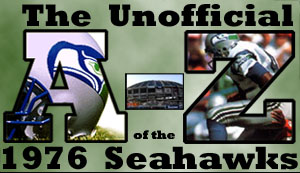
No longer a child, not yet middle-aged, and still finding their place in the NFL world.
...the 30-year wall of silence is an impressive achievement for a League that leaks as a lifestyle.
He recommended Jack Patera enthusiastically for the Seahawks...
The letter C is coming soon!
The Seahawks used Williams’ local reputation as a promotional tool, as they would do (very briefly) with Ahmad Rashad.
The average Seahawk selected in the veteran allocation is 6-2, 222 pounds, just under 26 years old and is entering his fourth NFL season.
The Seahawks played the Rams...facing off against future Seahawk coaches Chuck Knox, Tom Catlin and Ken Meyer.
...management decided early to pursue coaches with no NFL head coaching experience.
Patera had the boldness to recruit 3 coaches with no NFL service...
...why was there no place for one of the ultimate local heroes of the early 1970s – Sonny Sixkiller?
Thompson may have looked on paper like a conservative and safe manager for a new team with first-time owners, but...
...reports from the camp are unclear as to who did the special team evaluations.
As a defensive coach, Jack Patera valued his linebackers.
Maybe we'll come up with something soon!
...nobody else on the Seahawks squad took their dislike quite to the extent of Ahmad Rashad.
The Nordstroms were an obvious possibility because of their wealth and local presence.
Approximately 14 members of that squad would never play for the Seahawks again.
A simple lesson in draft history is to list the fate of quarterbacks for several years before 1976.
Jack Patera was unable to take a single Redskin veteran from the allocation list.
...the Seahawks’ offense would be directed by 3 men who had 2 years of NFL experience between them
Terry Brown’s Seahawk career lasted less than 24 hours.
...we think this story might just have been a good Patera Prank!
While Patera had an inside edge on stocking his team with Vikings, he only chose one Viking from the allocation...
Character would clearly play a part...
Patera lived up to his code of we will tolerate you until we can replace you...
Yes! We will have something for Y eventually!
What more need we say?
|
Intro |
A |
B |
C |
D |
E |
F |
G |
H |
I |
J |
K |
L |
M |
N |
O |
P |
Q |
R |
S |
T |
U |
V |
W |
X |
Y |
Z |
Home

W is for Winners
One of the many problems facing the Seahawks was to assemble a squad that was intelligent enough to learn the new system while being resilient enough to endure the likely setbacks along the way. Character would clearly play a part, especially in terms of having the “winning attitude” that so many people talked about during the first season.
Jack Patera, of course, had been a winner for 10 seasons, and was well aware of the intangibles a player needed to have a winning attitude. However, his success in achieving the magic formula was decidedly mixed. Accepting that injuries and bad luck played their usual parts, it’s still true that his most profitable sources of talent and dedication didn’t always come from the places you’d expect. The following table is a reminder of how hit-and-miss the recruitment process is — and how much work was done by the existing teams to shield their better players! For Seattle to find so little talent from the 11-3 Raiders and Bengals is extraordinary, while the struggling Lions and Bears provided some excellent returns. Players who were acquired after 1 July are listed in italics.
There’s no guaranteed equation of “winning team = winning attitude”. Many struggling teams include players of great heart and character precisely because they are strong people in the struggle, while players in successful teams are often spared such harsh tests of courage. The mystery is still how the successful teams, with deep rosters of quality, managed to lose so few impact players in the allocation. They did lose good players, but how did they manage to keep so many? From the Seahawks’ perspective, they quickly identified the veterans from whom they expected leadership and drive. Their promotional material zoomed in on 8 players: Norm Evans, Al Matthews, Don Hansen, Fred Hoaglin, Eddie McMillan, Bill Olds, Ken Geddes and Mike Curtis. Their instincts were right about most of them, but it’s also significant that all but Matthews and Hansen came from winning teams.
|